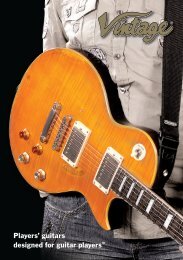GEAR 23_COVER - JHS
GEAR 23_COVER - JHS
GEAR 23_COVER - JHS
Create successful ePaper yourself
Turn your PDF publications into a flip-book with our unique Google optimized e-Paper software.
PA’s, whether large or small, conventionally have always tended towards a traditionally symmetrical<br />
‘stereo’ layout to them. Now though Fishman’s innovative line array-based SoloAmp makes a good<br />
case for a re-write of the PA rulebook, reckons Brian Barnes.<br />
‘Because the hardest thing a performer should have to carry is a<br />
tune’ is how Fishman themselves advertise their intriguing new<br />
SoloAmp PA system. Well, we like the sound of that already.<br />
Aimed primarily at the performing singer/songwriter, SoloAmp<br />
is intended to provide ‘exceptional sound quality and coverage’,<br />
thanks to its stated ability to pump out 220 watts of clean<br />
power via a vertical line array of six custom high-excursion<br />
speakers and soft-dome tweeter. Radical...<br />
So why have we tended to accept over the years that in club<br />
and pub-sized gigs, the twin speaker column PA set-up is best?<br />
Well, this is effectively an optimum way of spreading the FOH sound<br />
screen at most gigs in a balanced output format for us two-eared,<br />
stereo-detecting humans. Mostly though, live gigs feature mainly<br />
mono sound going into two output channels, but the twin speaker<br />
layout still works well in providing optimal sonic coverage. So you<br />
might look at the SoloAmp set-up and think, ‘where’s the other<br />
column then?’ perhaps followed by ‘where’s the amp and mixer?’...<br />
Obviously there are many more conventional styles of<br />
acoustic amplifiers available on the market, including<br />
Fishman’s own excellent Loudbox, offering full range<br />
reproduction with facilities for vocal input as well as<br />
an instrument. However, these are more often than<br />
not floor-mounted units, even though in the case of<br />
the Loudbox they are in a monitor wedge style format<br />
with the sound projecting forwards and upwards.<br />
However, this can only ever offer limited audience<br />
coverage unless the sound is also fed into a dedicated<br />
accompanying PA, which is a significant additional<br />
cost factor – and a lot more to carry in to the gig.<br />
Commendably, Fishman have looked at these problems<br />
with a more ‘wide-screen’ approach. With the SoloAmp,<br />
Fishman have opted to utilise state-of-the-art line<br />
array technology, notable by its distinctive ‘vertical<br />
tower’ speaker arrangement designed, say Fishman, to<br />
‘With the SoloAmp, Fishman have opted to utilise<br />
state-of-the-art line array technology’<br />
When confronted with the Fishman SoloAmp for the first time,<br />
especially if you haven’t really considered what it might physically<br />
look like, there are a number of surprises in store for you where your<br />
brain might have to have its ‘reset’ button pressed.<br />
You might also have heard that the SoloAmp focusses heavily on<br />
the use of ‘new technology’, and so maybe you’re expecting some<br />
crazily mad futuristic-looking box of techno-tricks. If that’s the case,<br />
then that first look at Fishman’s SoloAmp will leave you seriously<br />
impressed by how elegant, stylish and<br />
compact it all looks – minimalist and<br />
‘futuristic’ too, even – and how<br />
well engineered the unit is.<br />
provide ‘... exceptional sound quality and coverage’ with<br />
its compact line array set-up.<br />
SOLOAMP SPECIFICATION<br />
Okay, so that’s a brief intro, and we’ll check out how it all<br />
performs in a paragraph or two, but what sort of specification<br />
is involved? Well, as stated, the SoloAmp is designed to<br />
pump out a healthy 220 watts RMS; behind that<br />
chunky protective perforated metal front<br />
grille are no less than six vertically-stacked<br />
4” mid-woofers pushing out 200 watts<br />
via a servo power amp, with a single<br />
1” neodymium soft dome tweeter<br />
adding the remaining 20<br />
watts. The internal<br />
servo power amp<br />
eliminates the<br />
need for any<br />
additional bass-boosting subwoofer, and the enclosed tower also<br />
includes all the related electronics, amplifier and controls for the system,<br />
greatly increasing the portability and convenience of the SoloAmp.<br />
Better still, much of the technology used in the SoloAmp comes<br />
from already having proved itself in their Loudbox units.<br />
So, it’s a two-channel, full-range system where, on<br />
the impressively user-friendly recessed front control<br />
panel, both mic/instrument channels feature<br />
both balanced XLR and unbalanced standard jack<br />
inputs. Switchable 48v phantom power is available<br />
for each channel alongside independant 10dB input<br />
gain pad push switches. Each channel has its own<br />
column of 3-band EQ rotaries, with the input Gain rotary<br />
and accompanying clip warning LEDs. Four selectable levels<br />
12

















